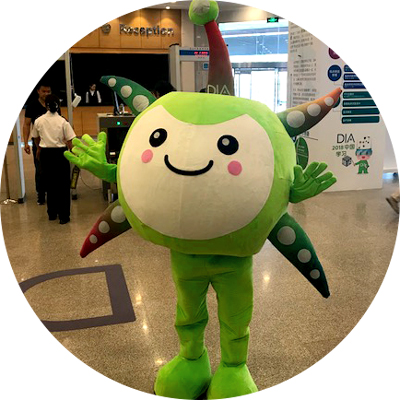Proceedings: DIA China 2018

Joining the Global Community
DIA China Celebrates 10th Annual Meeting
Joining the Global Community
DIA China Celebrates 10th Annual Meeting
Joining the Global Community
DIA China Celebrates 10th Annual Meeting
Ling Su
Shenyang Pharmaceutical University,
Lilly Asia Ventures
eijing, May 23, 2018. DIA China 2018 marks the tenth anniversary of the DIA China Annual Meeting. Attracting more than 3300 participants from across the globe, including over 370 speakers in more than 80 sessions, this DIA China flagship meeting has become a major multidisciplinary event in the healthcare product development and regulation arena in China.
Since the inception of this annual meeting ten years ago, China’s importance to the global innovation, clinical, regulatory, and healthcare communities has continued to grow. In 2017, the regulatory reform that was started two years ago has achieved significant progress and the Chinese regulatory agency became a full regulatory member of ICH. Also in 2017, the CFDA approved a record number of imported new drugs and received the highest number of innovative new drug applications since 2012.
“We will continue to deepen the regulatory reform,” said Jiao Hong, the newly appointed commissioner of the China National Drug Administration (CNDA, the agency that replaces the CFDA as part of the government reorganization in March 2018), in her speech in the opening Plenary Session. “We will continue to build up an efficient, transparent, and internationally aligned regulatory system to enhance our review quality and efficiency, encourage innovation and improve access of innovative medicines. We will take a risk-based approach and strengthen our enforcement,” Jiao added. She also emphasized that the CNDA will continue to engage in broader and deeper collaboration and exchange with other regulatory bodies around the world and will develop talents who are adaptive to the need of globalization. (Read excerpts of Commissioner Jiao’s speech.)
Also in the opening plenary session, Dr. Sang Guowei, Academician of the Chinese Academy of Engineering and the renowned leader of China’s National Science & Technology Special Program on Innovative Drug Development, reflected on the progress of this program and his participation in DIA activities. He said, “The standards for the development of new drugs in China must be in line with international standards.” He complimented DIA, which has “made important contributions to the promotion of drug development and capacity building in China, as well as the international exchanges.” Dr. Sang had previously been the keynote speaker at the first and fifth DIA China Annual Meetings.
Highlights of DIA China 2018 included:
CNDA Town Hall: This popular session featured speakers from CNDA’s department of drug registration, Center for Drug Evaluation (CDE), Center for Food and Drug Inspection, and Center for Medical Device Evaluation, who provided comprehensive and timely updates on the various fronts in the regulatory system, from regulatory review and approval to inspections. Regulatory reform continues to make good progress; for example, the backlog of 20,000 marketing approval applications has been reduced to around 4,000. Several mechanisms have been implemented in CDE to speed up review and approval including priority review, project management, sponsor-reviewer meetings, and communications. More reform measures will be forthcoming, such as the long-awaited 60-working-day IND review process. In addition, the agency is increasing regulatory inspections to ensure quality. In 2017, there were 317 more inspections conducted than the prior year, a 173% increase. The areas of the greatest increase were GMP inspections, flight inspections, and overseas inspections.
Hospital Presidents Forum: This first-ever forum brought the presidents from six leading research hospitals together to discuss with the audience their experience and insight on the build-up of the clinical research system, education, and training for medical research professionals as well as measures conducive to conducting clinical trials in medical centers. Clinical research is a driving force for modern medicine development and a key link to drug innovation. However, according to data from clinicaltrials.gov, clinical trials conducted in China account for only a small proportion of clinical trials conducted worldwide. Clinical research capacity is becoming a bottleneck for drug development in China. To address this challenge, Yuanbin Wu, Director-General of the Department of Science and Technology for Social Development from the Ministry of Science and Technology, told the audience that the Ministry is planning to establish a clinical research system to upgrade the country’s clinical research infrastructure and capability. The current hospital incentive system would need to be adjusted as well, he said, since the system currently does not reward medical doctors and staff for conducting clinical trials.
DIAmond Sessions covered contemporary topics such as real-world evidence for regulatory considerations; unmet medical needs in current therapies for liver disease; patient engagement in drug development; keys to success in the global generic drugs market; ICH E2; and artificial intelligence and big data in medical reform and drug development.
In addition, to support the implementation of ICH guidelines in China, an ICH-approved full-day training (CFDA/DIA Joint ICH Day) was held on May 22 in conjunction with the Annual Meeting. Informative speakers included Lenita Lindström-Gommers, Chair of the ICH Assembly and Senior Expert of European Commission, who presented the current ICH priorities and challenges in implementing the ICH reform; Dr. Toshiyoshi Tominaga, Vice Chair of the ICH Assembly and ICH Management Committee and Associate Executive Director of PMDA, who discussed ICH guideline development and new topics selection; and Siyuan Zhou, Director of the China ICH Office of the CNDA, who provided an update on the implementation of ICH guidelines in China. Six training workshops were held on several ICH guidelines: E2 & M1, E6(R2), E9(R1), E17, E14, and M4 & M8.

